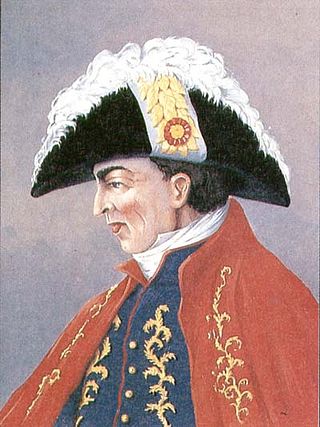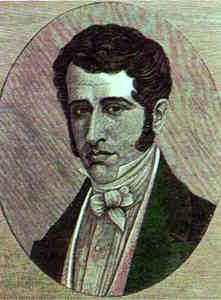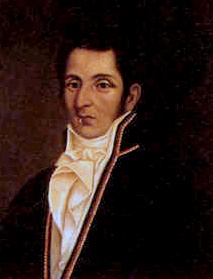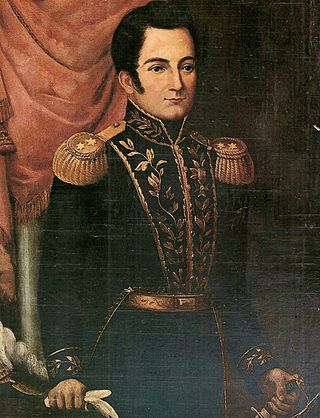Province of Cartagena de Indias (1832-1841)
| | This section is empty. You can help by adding to it. (July 2010) |
The Province of Cartagena de Indias in Colombia was founded concurrently with the city of Cartagena, Colombia in 1533 by the conquistador Pedro de Heredia, thus fulfilling his part in a contract of conquest made with King Charles V of Spain. [1] The town and province were named after Cartagena, Spain, the hometown of most of Heredia's sailors. [2]
The province became independent during the 19th century, and essentially preserved its original territorial area, although it had changed names several times. [3]
The following is a list of the governors or presidents of the Province of Cartagena, [4] [5] later known as the "Republic of Cartagena". [6]
In response to the demands of the people, the Junta de Gobierno of Cartagena declared its independence from the Spanish Crown and the abolition of the Inquisition on November 11, 1811. The Junta issued an acta de independencia declaring: "the Province of Cartagena de Indias is from today, in fact and by law, a free, sovereign, and independent state." [7] Leaders of the territory when it was an independent nation are also included here.
The Province of Cartagena in its initial form lasted from 1533 to 1810, during which time the title of the province's chief executive was Governor. With exceptions in 1539 and 1540, provisional leaders served without that title. During the Viceroyalty of Peru, the administrative power of the governor diminished due to the presence of the Viceroy in Cartagena de Indias and its selection as the alternative capital of New Kingdom of Granada.
During this period, the corregidor , or alcalde mayor, of Cartagena de Indias had both judicial and administrative powers, while the colonial governor was the military and budgetary authority in the province and semi-corregidor of the capital city, which because of its economic importance had significant autonomy from Bogotá, and played a vital role in the balance of powers in New Granada. [8]
In the 18th century Cartagena de Indias was the preeminent city of the New Kingdom of Granada, its port controlling most of the colony's trade. The Spanish government had built an imposing fortress, the Castillo San Felipe de Barajas, in a strategic location on the Hill of San Lázaro, which dominated all approaches to the city by land or sea. Cartagena controlled the region commercially, politically, and militarily, and served as headquarters for Spanish army and naval stations on the Caribbean coast. [8]
In this list appears the title, name, length of the governorship and notes about the incumbent.
The events of the Peninsular War and the convocation of Juntas throughout Spain transformed the traditional order. Although everything remained the same, the instability of this period makes almost impossible to state what was the precise status of the province.
This triumvirate was fragile and was replaced by a "Supreme Junta" where the locals had more power, this could be regarded as a sort of fight between the virtually nonexistent royal power and the city councils.
By this time chaos dominated the political scene, with many advocating independence of the viceroyalty, others of the province, others the return of the Ancien regime, while yet others, desiring stability, wanted to maintain the status quo under the present governorship, or whatever title given the office, which always represented a short-lived victory of one faction or another.
In August 1820, the Province of Cartagena was annexed to Greater Colombia and the revolutionary wars finally ended. In 1821 Cartagena and Santa Marta provinces merged in the Intendency of Magdalena Department, and were governed by a Prefect Intendent from Cartagena de Indias.
| | This section is empty. You can help by adding to it. (July 2010) |
| | This section is empty. You can help by adding to it. (July 2010) |
| | This section is empty. You can help by adding to it. (July 2010) |
| | This section is empty. You can help by adding to it. (July 2010) |
Sr. Coronel Máximo Lorduy Cárdenas (1864;1866) Coronel de la Guarda Nacional. Alcalde de la ciudad de Cartagena de Indias en 1864 y 1866. Artesano (oficio heredado de su ascendiente el Maestro carpintero Pantaleón Lorduy). Ver: Luis Carlos Lorduy Vergara. Lorduy, Genealogía de un Apellido. Cartagena: Casa Editorial, 2010. https://lorduygenealogia.wixsite.com/aniversario ==Department of Bolivar (1886-today)==
| | This section is empty. You can help by adding to it. (December 2015) |

Cartagena, known since the colonial era as Cartagena de Indias, is a city and one of the major ports on the northern coast of Colombia in the Caribbean Coast Region, along the Caribbean sea. Cartagena's past role as a link in the route to the West Indies provides it with important historical value for world exploration and preservation of heritage from the great commercial maritime routes. As a former Spanish colony, it was a key port for the export of Bolivian silver to Spain and for the import of enslaved Africans under the asiento system. It was defensible against pirate attacks in the Caribbean. The city's strategic location between the Magdalena and Sinú Rivers also gave it easy access to the interior of New Granada and made it a main port for trade between Spain and its overseas empire, establishing its importance by the early 1540s.

The governor of the State of Yucatan is the head of the executive branch of the Mexican state of Yucatán, elected to a six-year-term and not eligible for reelection. The figure of the governor is established on the Constitution of the State of Yucatan on its Title Fifth. The term of the Governor begins on October 1 of the year of the election and finishes September 30, six years later.

The First Republic of New Granada, known despectively as the Foolish Fatherland, is the period in the history of Colombia immediately following the declaration of independence from Spain in 1810 and until the Spanish reconquest in 1816. The period between 1810 and 1816 in the Viceroyalty of New Granada was marked by such intense conflicts over the nature of the new government or governments that it became known as la Patria Boba. Constant fighting between federalists and centralists gave rise to a prolonged period of instability that eventually favored Spanish reconquest. Similar developments can be seen at the same time in the United Provinces of the Río de la Plata. Each province, and even some cities, set up its own autonomous junta, which declared themselves sovereign from each other.

Mateo de Toro Zambrano y Ureta, 1st Count of La Conquista, was a prominent Spanish military and political figure of Criollo descent. He held the position of a knight in the Order of Santiago and was the lord of the Toro-Zambrano estate.

Pedro de Heredia was a Spanish conquistador, founder of the city of Cartagena de Indias and explorer of the northern coast and the interior of present-day Colombia.

Antonio José Amar y Borbón Arguedas was a Spanish military officer and colonial official. From September 16, 1803 to July 20, 1810 he was viceroy of New Granada. During his mandate he faced the beginning of the independence movement. He is also remembered for introducing costumes and masked balls in the society of Bogotá.

José Miguel Pey y García de Andrade was a Colombian statesman and soldier and a leader of the independence movement from Spain. He is considered the first vice president and first president of Colombia. He was a centralist.

Juan José Francisco de Sámano y Uribarri de Rebollar y Mazorra, was a Spanish military officer and the last viceroy of New Granada from from March 9,1818 to August 9, 1819, during the Colombian War of Independence.

José Luis Álvaro Alvino Fernández Madrid was a Neogranadine statesman, physician, scientist and writer, who was President of the interim triumvirate of the United Provinces of New Granada in 1814, and President of the United Provinces of the New Granada in 1816. After the Spanish retook New Granada, he was barred from the country and was exiled in Havana, where he continued his scientific studies and worked as a doctor. He was later pardoned and allowed to come back to Colombia, and was appointed ambassador to France and to the United Kingdom where he died in 1830.

The Real Audiencia of Quito was an administrative unit in the Spanish Empire which had political, military, and religious jurisdiction over territories that today include Ecuador, parts of northern Peru, parts of southern Colombia and parts of northern Brazil. It was created by Royal Decree on 29 August 1563 by Philip II of Spain in the city of Guadalajara. It ended in 1822 with the incorporation of the area into the Republic of Gran Colombia.

Antonio Villavicencio y Verástegui was a statesman and soldier of New Granada, born in Quito, and educated in Spain. He served in the Battle of Trafalgar as an officer in the Spanish Navy with the rank of Second Lieutenant. He was sent as a representative of the Spanish Crown to New Granada, where his arrival was used as an excuse in Santafé de Bogotá to start a revolt; this was known as the Florero de Llorente, which culminated in the proclamation of independence from Spain. After this incident he resigned his office and joined the cause of independence. He was later captured and became the first martyr executed during the reign of terror of Pablo Morillo.

Manuel Rodríguez Torices was a Neogranadine statesman, lawyer, journalist, and Precursor of the Independence of Colombia. He was part of the Triumvirate of the United Provinces of New Granada in 1815, and served as Vice President of the United Provinces after the triumvirate. He was executed during the Reign of Terror of Pablo Morillo in 1816.

Mariano Montilla was a major general of the Army of Venezuela in the Venezuelan War of Independence.

The Colombian Declaration of Independence occurred on July 20, 1810 when the Junta de Santa Fe was formed in Santa Fe de Bogota, the capital of the Spanish colonial Viceroyalty of New Granada, to govern the territory autonomously from Spain. The event inspired similar independence movements across Latin America, and triggered an almost decade-long rebellion culminating in the founding of the Republic of Colombia, which spanned present-day Colombia, mainland Ecuador, Panama, and Venezuela, along with parts of northern Peru and northwestern Brazil.
This article is the History of Cartagena, Colombia.

Cartagena Province, also called Gobierno de Cartagena during the Spanish imperial era, was an administrative and territorial division of New Granada in the Viceroyalty of Peru. It was originally organized on February 16, 1533 as a captaincy general from the central portion of the Province of Tierra Firme. In 1717, King Philip V of Spain issued a royal decree creating the Viceroyalty of New Granada, by which the province was added to the latter.

The Villa de Santa Cruz de Mompox was founded by Don Juan Quintero de Heredia, Adelantado of the Gobernation of Cartagena and brother of the founder of that city, Pedro de Heredia, on May 3, 1537, after fighting battles against the Kimbay tribe and defeating the Chieftain Mompoj.
Martín Yañéz Tafur was a Spanish conquistador who participated in the foundation of Cartagena, the Spanish conquest of the Muisca and the conquest of the Panche.